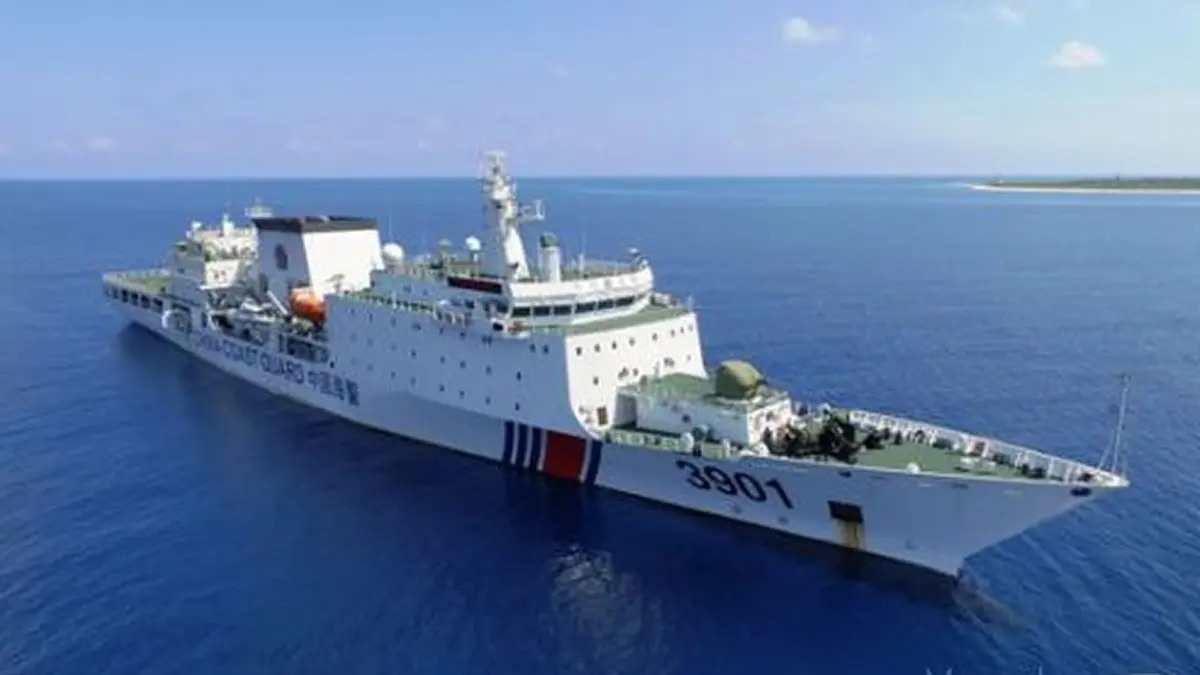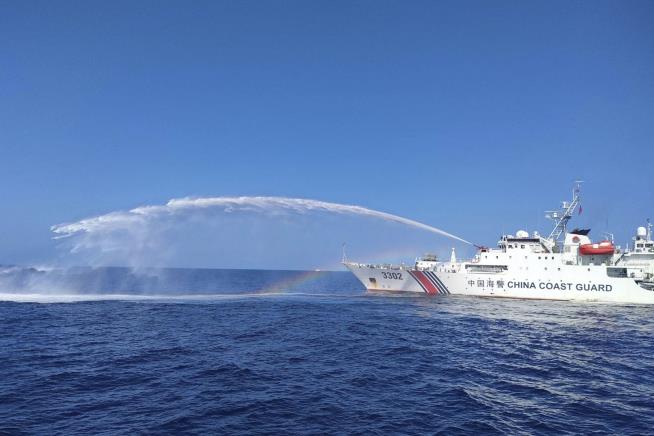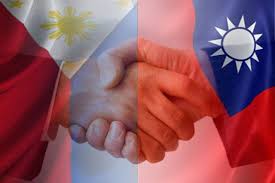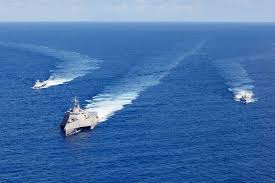by Benjamin Blandin
re published from KIMS periscope with permission from author
Since the end of 2023, China has been scaling up the regularity, the diversity and the degree of violence of its action against the Philippines, using either sonars and surface sonic weapons, pointing floodlight projectors, jamming Filipino ships sensors, GPS and comms, employing helicopters and go-fast ships as means of intimidation, firing double-barreled water cannons at full power and point-blank range against fragile and unarmed wooden supply ships, and even, more recently, painted its maritime militia vessels to the China Coast Guard’s colors in order to blur the lines.
But is that anything new given the pattern of China’s behavior ever since the 1970s and 1980s, like when it fired anti-aircraft guns at unarmed Vietnamese soldiers stranded on Johnson South Reef, or when it built “weather stations” in the Spratlys in 1988, and fishermen shelters at Mischief Reef in 1995, both low-tide elevations that were in turn transformed into full-fledge naval and air bases just twenty years later, right after Xi Jinping promised they would be neither reclaimed nor militarized. And we should not forget the two major incidents that occurred in the EEZ of Vietnam back in 2014 and 2019 or the surprise takeover of Scarborough Shoal in 2012. Other actions have been witnessed in the Taiwan Strait, around the Senkaku Islands and in the Yellow Sea, in fact all over its near seas’ perimeter.
Over the years, experts have been giving a variety of reasons to explain such behavior, whether it is to control natural resources such as fish, polymetallic nodules and oil and gas, or to create a buffer zone in order to keep the United States away from a vital commercial artery, to secure a space to conduct military exercises, or to dilute the submarines harbored at Yulin naval base in Hainan, secure a future invasion of Taiwan, to (re)establish a regional predominance or prevent a return of the so-called “century of humiliation”. Let’s explore some of these to try understand what exactly is behind China’s aggressiveness.
A complicated link between China and Taiwan
To begin with, let’s address Taiwan that seems to have been more and more at the center of China’s attention over the years. Even though some “wolf warrior” Chinese diplomats like the Chinese ambassador to France, H.E. Lu Shaye, pretend that Taiwan has been part of China since Jesus Christ, the reality is somewhat very different and it is a fact that the first ethnic Chinese to land in Taiwan, aside from the Pescadores archipelago, were laborers recruited by the European colonial powers (Netherland, Spain, England, Portugal) to work in the plantations that had been established there.
It is important to notice that Taiwan has not been occupied by China before 1683 following the defeat of the Tungning kingdom, Ming loyalists and pirates that had previously defeated the Dutch and settled on the island after being evicted from the mainland. That same year, Taiwan also appeared for the first time on an official Chinese map, but it did not refrain Emperor Kangxi himself to see Taiwan merely as a “ball of mud beyond the pale of civilization”, unworthy of his attention”.
For the most part of the Chinese presence, underpopulation and constant conflicts with the aboriginal population plagued the authorities. Even in 1895, despite numerous campaigns from the successive governors to fight the Taiwanese tribes and open the countryside to settlers’ penetration, only half of Taiwan was controlled by the Chinese government at the time of Japanese invasion, a reality that had already been made clear during the Mudan incident of 1871, when the governor told the Japanese forces that the incident had taken place in an area that was out of his control.
Another major element to take into account is that between 1922 and 1942, when the Chinese communist forces were based in Yan’an, their position was that Taiwan (and Korea) was a separate nation that they wanted to help to get free from the Japanese occupation, a position confirmed by Mao Zedong himself in 1937 in an interview with American journalist Edward Snow. A position that was to change dramatically following the defeat of the Guomindang and its retreat to the island.
A non-existing historic legitimacy in the south sea
Regarding the South China Sea, called “South Sea” in China prior to the 20th century, and “Champa Sea” for centuries before that by most of its neighbors, we should remember that all maps published by China until 1932 mentioned Hainan as its southernmost point, it is only after the French took control of and claimed the Paracels (1932) and later the Spratlys (1933), that the Chinese authorities started claiming these same areas, pushing their southernmost point from Hainan to the Paracels, later to the Spratlys and now all the way to James Shoal, a submerged reef 22 meters below water, and updated their maps to accompany these new claims. Still, until the 1990s, all the South China Sea features’ names on Chinese maps were mere word-by-word translations of English names, even though China pretends it has first discovered and named both archipelago’s features since ancient times.
But these claims were empty as China, as a country, had never specifically patrolled, occupied, populated, exploited or developed (building structures and/or infrastructure) any of the now disputed maritime features, before at least the early 20th century for the Paracels and the 1950s for the Spratlys. The only regular Chinese presence that existed over the centuries was that of fishermen from Hainan and eventually from Guangdong or Fujian that occupied from time to time a handful of features, exclusively in the Paracels, in order to rest, collect turtle eggs, replenish water at some of the rare drinkable wells, and prey the goddess of the sea. A reality demonstrated by the fact that until the late 19th century, the favorite way to cross the South China Sea was to do so along the coasts, using cabotage, the “Dangerous Ground” area being generally avoided for its numerous low tide elevations.
It is telling that in 1938, Mr. Wang Gong Da, then director of the influential Peiping News, wrote the following to the Foreign Affairs Secretary: “The Spokesperson of the Foreign Affairs said that a protest was prepared if it was proven that the nine islands (the Spratlys) were part of the Xisha (the Paracels). Don’t make a diplomatic blunder, these islands are not part of Xisha. Triton Island is the southernmost part of our territory. South of Triton Island, there is no connection with the Chinese territory. Our so-called experts, geographers, and Navy officers are a shame to our country”.
It is also a fact that until 1949, the communist party of China had made no claim whatsoever on either the Paracels or the Spratlys. It seems that it is only after the forces of the Guomindang had published in 1948 their map displaying the then eleven-dash line, that the Communist leadership decided to incorporate all of the nationalist’s claims when declaring the New China, in order to deprive them of any legitimacy and to rally the population a significant portion of which they knew was not supporting them all heartedly. But there is a major difference between claiming and acting, and following the takeover of Hainan, it would take about twenty-five years before communist China move on to cease the whole of the Paracels and another 14 years after that for the Spratlys, following the 1974 and 1988 naval battles between mainland China and either South Vietnam or reunified Vietnam.
In more recent times, neither the Republic of China (Taiwan) nor the People’s Republic of China (Beijing) have ever published the coordinates of the dashes, even in the 2009’ PRC declaration to the UN, whom number has changed over time (eleven, then nine, then ten dashes), and which shape has moved over time, nor have they made clear what they claimed within the dashed line. Indeed, there are about seven or more different versions circulating between the various ministries, administrations, think tanks and even propaganda movies such as “Born to fly” (2023), none having been made the official one. A dashed line that was made null and void following the ratification of UNCLOS, as was made perfectly clear by the decision of the PCA in 2016 in the Philippines v. China case.
The same goes for the notion of historic rights (at the exception of historic bays and traditional fishing grounds), a rather recent notion as it was put forward by the Republic of China (ROC) only in 1993, and that the People’s Republic of China copied in the late 1990s and early 2000s, in parallel of a number of techniques such as the use of vague, pseudo-legal, wording such as “waters under China’s jurisdiction”, “adjacent waters” and other terms, and a failed attempt to draw archipelagic baselines around low-tide elevations, far over-stretching a concept that can only be applied by archipelagic countries such as South Pacific nations like Vanuatu and Micronesia.
A limited interest for the natural resources
It has been said in various occasions and by different experts that China might be motivated by the access to the natural resources it so desperately needed with a population avid for fresh sea food and with an ever-growing consumption of sea-sourced proteins (from 5 to 35 kg per person per year between 1960 and 2020), including fish, giant clams, squids, and sea cucumbers. Even though these trends might be true, it is also a fact that these same needs are being already met by the growing long distance fishing fleets roaming the Pacific and Indian oceans, and by the national aquaculture industry that now accounts for 60 million tons or 82% of the total production.
The situation seems to be the same about oil and gas and it is a fact that despite seemingly overly positive estimations by a United Nations body in 1969, exploration and production has not boomed in most of the area of the South China Sea ever since, except for Malaysia in the Luconia Shoals area and for the Philippines (in a much more limited fashion). Indeed, after the short lived Joint Marine Seismic Undertaking agreement between China, the Philippines and Vietnam (2005-2008), and a later attempt between China and the Philippines under Duterte didn’t conclude either after China refused that the contract indicates Reed Bank as a Filipino territory. Moreover, after the 2014 and 2019 incidents in the Vietnamese EEZ, China has experienced much more success in its own EEZ with the Kaipingnan oilfield, south of Shenzhen (2023), and with the Bohai 26-6 oilfield east of Tianjin in the Bohai Sea (2024).
Also, China is currently moving fast toward an electrification of individual and collective mobility (including the very first high speed rail network in the world), has invested massively in solar power plants and wind farms, the development of the national energy industry, and seriously reduced its dependency on the traditional supply lines from the Middle-East for its supply of oil and gas through the increased national production and by building various infrastructures in cooperation with Russia, on top of the development of the Myanmar and Pakistan corridors.
All of these elements plead for a reduced interest and dependency, but other non-economic interests might actually take prevalence over them, including the desire or perceived need to build a buffer zone, keeping the US and other QUAD actors at a safe distance, to reinforce its influence over its neighbors, or to create a space for its submarines to safely “dilute” before reaching the Pacific Ocean.
A complicated economic situation
The current economic and social situation in China is particularly difficult, between industrial over capacities and an unsustainable growth target, with regions under pressure from the central authorities to invest in infrastructure projects, often leading to ego projects including ghost towns for up to two million people, highways to nowhere, airports with no flights and giant train stations with no passengers, in order to support the economy, maintain the growth target and provide jobs. Successively, the authorities have in fact severely damaged the tourism and hospitality industries, as well as the video game industry, the private tutoring industry (two million jobs suppressed), and the construction industry with all associated sectors, all the while experiencing a halt to foreign investments and the beginning of divestment from major industrial and technological groups, a succession of stock market crashes, with millions of people either out of a job, with their savings whipped out, or forced to repay loans for an apartment or a house that they will never be delivered.
Some state sponsored projects such as the national high speed rail network, a true matter of national pride, are now severely indebted, and the regions supporting them with it, with too many stations being unprofitable and sometimes unused, and the production and maintenance of an over-large fleet, draining local, regional and national stakeholders’ finances with no light at the end of the tunnel so far. Finally, it is important to remind the reader that despite thirty years of constant double-digit growth and a near-daily supply of world records, it is a reality, soberly reminded by former Prime Minister Li Keqiang in 2020 that half of the population, 600 million people, barely make ends meet with 140$ monthly income when even Moldova, Europe’s poorest country, reaches 552$ average monthly salary.
A growing aversion to political instability
In conclusion, it seems clear from the above that not only China has no basis to claim either or both of the Paracel and Spratly archipelagos, or Taiwan and the Senkaku islands for what matters, but that it has completely reversed its policies after 1949, following its victory over the Guomindang, seemingly in order to gather the nation and deprive its adversary of any legitimacy after their retreat to Taiwan.
A lack of legitimacy that has been countered by the constant need of the Chinese authorities, especially after the disasters of the great leap forward, the one hundred flowers campaign, the three anti and five anti campaigns and the cultural revolution, to show the determination and resolve of the state, to accomplish the national rejuvenation and reunification, and the end of the “century of humiliation”. As such, I believe that China could not care any less about both Vietnam and the Philippines, that it seems to see as unfortunate collateral damage in its vast and ever-growing campaign of asymmetric warfare.
A Chinese maritime lawyer with whom I discussed with last year told me about incidents at Scarborough Shoal and Second Thomas Shoal: “The issue that we have in China is that we have this vision that what we receive from our ancestors, no matter good or bad, we have to uphold and preserve otherwise we lose the protection of heaven;” and in the case of the Chinese authorities, it would mean losing face toward the population”, therefore risking political instability, which would threaten the grip of the communist party of China on the country, an unacceptable scenario for both the military, security and political authorities.
Nevertheless, Xi Jinping has succeeded in “turning the tides” and make an opportunity out of a major obstacle by using a seemingly unsolvable situation to divert the attention of the population from the economic and social difficulties, unite them (by force if need be) behind the communist party of China, allocate part of the excess steel production to the production of new corvettes, frigates, destroyers and aircraft carriers, on top of logistics and support, and amphibious vessels, constituting long term assets for the nation, in turn creating new jobs in industry to produce, maintain and modernize the ships, but also in the navy to crew the ships, and in the defense industry.
Now, we must hope that the scenarios of a major move by China in either 2025, 2027 or 2030 will not materialize, and that Xi Jinping or whomever takes his place after him, will not take the excuse of the ongoing difficulties to launch a major confrontation with the US and/or the West to reunite the people behind a common goal of taking Taiwan back, no matter the cost, surely a grueling scenario that, based on scenarios from Bloomberg, would have catastrophic consequences for the whole world.
- Author BIO
Benjamin Blandin is a PhD student in geopolitics at the Paris Catholic University. He was previously a Senior Consultant in strategy at Airbus Defence and Space and consulting firms such as Accenture, Deloitte and Capgemini. He graduated from Lyon Business School (EM Lyon) in strategy consulting, University Paris II (ISAD) in geostrategy and Paris 8 (IFG) in geopolitics. Benjamin Blandin is a former auditor of the Paris Military Academy (IHEDN) and Naval Academy (CESM).















